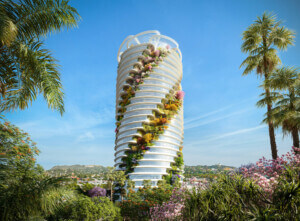Good afternoon and welcome back to another midweek news roundup; here’s what you need to know today:
Zaha Hadid Architects debuts a virtual gallery for NFT art at Art Basel Miami Beach
“Built” for a debut later this week at Art Basel Miami Beach, Zaha Hadid Architects’ (ZHA) latest project doesn’t really exist at all—it’s a virtual art and architecture gallery designed for the metaverse. At NFTism, the international Galerie Nagel Draxler and artist Kenny Schachter partnered to curate an inaugural show dedicated to artists working on the blockchain titled Breadcrumbs: Art in the Age of NFTism. Virtual visitors can explore a circular gallery built on the same technology underpinning today’s popular massively multiplayer online games (MMOs) to explore the digital art on view, complete with audio and visual interactivity.
An urban freeway cut through Detroit, and now the scar is being knit back together
The urban freeways of the mid-20th century, whether elevated or sunken, slashed American cities in half in the name of urban renewal, destroying neighborhoods, walkability, and livelihoods in the process. As the 21st century marches on, many cities are now looking into tearing down those same freeways and knitting their communities back together—and with the recent passage of the $1 trillion infrastructure bill, Detroit is looking to do the same. Interstate 375, a mile-long stretch of freeway spanned by no less than 14 bridges, will (hopefully) be transformed into a walkable boulevard lined by protected bike lanes and pedestrian paths. The project is expected to cost $270 million, with 80 percent of funding coming from the federal level and the remaining 20 percent from the state once the final design is approved by the Federal Highway Administration later this month. Construction is expected to start in 2027 but could likely begin earlier.
H/t to Grist
Amazon cloud services are helping further sun dimming studies
Amazon is donating cloud computing power to compute cloud power, affording climate researchers who can’t get time on a supercomputer with another avenue for modeling their work. However, there’s a twist: all 30 of the climate models from the National Center for Atmospheric Research currently running on Amazon’s servers simulate the effects of dimming the Earth’s atmosphere to modulate the amount of incoming sunlight. In these hypothetical futures from 2035 through 2070, carbon dioxide levels have risen to dangerous levels and humanity is grappling with runaway climate change, but reducing the amount of incoming sunlight (while it comes with a host of other serious problems) could also tame rising temperatures.
H/t to Gizmodo
Pieces of Frida Kahlo’s house are being sold as NFTs
In even more NFT news from Miami, Ezel.life, a digital asset management company, is selling off pieces of Mexican painter Frida Kahlo’s house as NFTs. An auction, reportedly backed by Kahlo’s family, will take place tonight as a soft launch for Ezel’s forthcoming “Frida Kahlo and Family Metaverse” project, which will put more information about the artist and her life online.
H/t to Artnet News
Work on the Air Force Academy chapel faces unexpected delays
The ongoing restoration of the Walter Netsch Jr.-designed Air Force Academy chapel, a soaring modernist triumph near Colorado Springs, Colorado, has hit a snag. The $158 million rehabilitation of the 14-story, triangular chapel will reportedly take up to a year longer than first thought after even more asbestos was discovered.
H/t to CPR News
Foster + Partners completes a spiraling timber winery in Bordeaux
Foster + Partners has completed a timber pavilion in Bordeaux, France, and the new Le Dôme Winery will allow visitors the opportunity to learn about winemaking at every step of the process. Wrapped by two ramps, one internal and the other external, the 32-foot-tall, 1,600-square-foot winery is topped by a gallery that gives guests panoramic views of the surrounding vineyards once they reach the top, as well as the production and storage facilities below.
H/t to Global Construction Review











